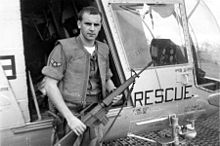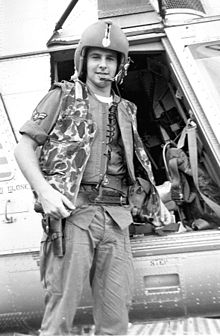|
William H. Pitsenbarger
William Hart Pitsenbarger (July 8, 1944 – April 11, 1966) was a United States Air Force Pararescueman who flew on almost 300 rescue missions during the Vietnam War to aid downed soldiers and pilots. On April 11, 1966, Pitsenbarger was killed aiding and defending a unit of soldiers pinned down by an enemy assault during the Vietnam War. Before his death, he helped save over 60 men in the battle.[1][2] He was posthumously awarded the Air Force Cross, which was later upgraded to the Medal of Honor.[3] Early life and educationPitsenbarger was born in 1944 to Irene and William Pitsenbarger. He grew up in Piqua, Ohio, a small town near Dayton. As a junior in high school, he tried to enlist in the U.S. Army as a Green Beret, but his parents refused to give their permission. After he graduated from high school, he decided to join the U.S. Air Force, and on New Year's Eve 1962, he was on a train bound for basic training in San Antonio. During his basic training in early 1963, he volunteered for Pararescue. Training included the U.S. Army Airborne School, U.S Navy Dive School (SCUBA), survival school, and a rescue and survival medical course. More Air Force rescue training and jungle survival school followed. His final training was in air crash rescue and firefighting.[4] He completed the requirements, and was one of the first group of airmen to qualify for Pararescue right out of basic training. After completing, he was assigned to the Rescue Squadron stationed at the Hamilton AFB, California. Vietnam WarPitsenbarger was later sent on Temporary Duty (TDY) to Vietnam. Upon completing his first TDY assignment, he volunteered to return and received orders in 1965 to report to Detachment 6, 38th Air Rescue and Recovery Squadron at Bien Hoa Air Base near Saigon.[5] His unit was composed of five aircrews that flew three Kaman HH-43F Huskie helicopters. His commander, Major Maurice Kessler, called him "One of a special breed. Alert and always ready to go on any mission." Pitsenbarger completed more than 250 missions, including one in which he hung from an HH-43's cable to rescue a wounded South Vietnamese soldier from a burning minefield. This action earned him the Airman's Medal and the Republic of Vietnam's Medal of Military Merit and Gallantry Cross with Bronze Palm.[4] On April 11, 1966, the Joint Rescue Center dispatched two Huskies from Detachment 6 to extract a half-dozen or more Army casualties pinned down in a battle near Cam My, 35 miles (56 km) east of Saigon. Upon reaching the site of the ambush, he was lowered through the trees to the ground where he attended to the wounded before having them lifted to the helicopter by cable. After six wounded men had been flown to an aid station, the two U.S. Air Force helicopters returned for their second load. As one of the helicopters lowered its litter basket to Pitsenbarger, who had remained on the ground with the 20 infantrymen still alive, it was hit by a burst of enemy small-arms fire. When its engine began to lose power, the pilot realized he had to get the helicopter away from the area as soon as possible. Instead of climbing into the litter basket so he could leave with the helicopter, Pitsenbarger elected to remain with the Army troops under enemy attack and he gave a "wave-off" to the helicopter which flew away to safety. With heavy mortar and small-arms fire, the helicopters could not return to rescue Pitsenbarger. For the next hour and a half, Pitsenbarger tended to the wounded soldiers, hacking splints out of snarled vines and building improvised stretchers out of saplings. When the others began running low on ammunition, he gathered ammunition from the dead and distributed it to those still alive. Then, he joined the others with a rifle to hold off the Viet Cong. Pitsenbarger was killed by Viet Cong snipers later that night. When his body was recovered the next day, one hand still held a rifle and the other clutched a medical kit.[citation needed] Although Pitsenbarger did not escape alive, the other 60 men did.[1][3]  He is buried in Miami Memorial Park Cemetery Covington, Ohio.[6] Medal of Honor awardSoon after Pitsenbarger was killed, his Air Force commanders nominated him for the Medal of Honor. An Army general recommended that the award be downgraded to the Air Force Cross, apparently because at the time there was not enough documentation of Pitsenbarger's actions.[3] Pitsenbarger received the Air Force Cross on June 30, 1966. After review and nearly 35 years later, the original award was upgraded.[4][7] On December 8, 2000, at the National Museum of the United States Air Force, the airman's father, William F. Pitsenbarger, and his mother, Alice, accepted the Medal of Honor from Secretary of the Air Force Whit Peters.[8] During the same ceremony he was also posthumously promoted to the rank of Staff sergeant. The audience included battle survivors, hundreds of pararescue airmen, a congressional representative and the Chief of Staff of the U.S. Air Force. Pitsenbarger was the 59th Medal of Honor recipient, and sixth enlisted recipient, from the Air Force and its predecessor organizations.[4] Medal of Honor citationThe President of the United States of America, authorized by Act of Congress, on December 8, 2000, has awarded in the name of the Congress the Medal of Honor posthumously to:  A1C WILLIAM H. PITSENBARGER
UNITED STATES AIR FORCE for conspicuous gallantry and intrepidity in action at the risk of his life above and beyond the call of duty near Cam My, April 11, 1966:
Rank and organization: Airman First Class, U.S. Air Force, Detachment 6, 38th Aerospace Rescue and Recovery Squadron, Bien Hoa Air Base, Republic of Vietnam.
Place and date: Near Cam My, April 11, 1966
Entered service at: Piqua, Ohio
Born: July 8, 1944, Piqua, Ohio
Citation:
CommendationsStaff Sergeant Pitsenbarger has been awarded the following:[10]
Honors and awardsPitsenbarger was the first enlisted recipient of the Air Force Cross medal, receiving the award posthumously in 1966.[5] The United States Navy Container Ship MV A1C William H. Pitsenbarger (T-AK-4638) was christened in his honor, but was decommissioned and returned to its original owner in 2008 with the new name Black Eagle. In addition several buildings have been named in his honor including William H. Pitsenbarger Dining Hall, Wright-Patterson Air Force Base, Ohio; William H. Pitsenbarger Professional Military Education Center, Beale Air Force Base, California; William H. Pitsenbarger Airman Leadership School, Spangdahlem Air Base, Germany; Pitsenbarger Hall, Randolph Air Force Base, Texas and Pitsenbarger Fitness Center, Sheppard Air Force Base, Texas. His name can be found on Panel 06E Line 102 of the Vietnam Veterans Memorial. Civilian authorities have also honored his name. The city of Piqua, Ohio, renamed a recreational park (which includes the municipal swimming pool) the "Pitsenbarger Sports Complex." In 2005, the State of Ohio designated State Route 48 as the "U.S.A.F. Pararescue Memorial Parkway." The highway runs near the hometowns of four pararescuemen who died in service to their country. This includes Pitsenbarger; Sgt. Jim Locker of Sidney, Ohio; Master Sgt. William McDaniel II of Greenville, Ohio; and Airman 1st Class James Pleiman of Russia, Ohio.[11][12] In addition to being designated Main Street through the city of Dayton—where the Wright Brothers designed their airplane—state route 48 also runs along Miami Memorial Park north of Covington, Ohio, where all four are buried. Edison Community College in Piqua, Ohio, awards the Pitsenbarger Scholarship to two full-time students per year who can show financial need. The drill team of the AFJROTC unit at Martinsburg High School, Martinsburg WV is known as the Pitsenbarger Rifles. The Air Force Association awards a $750 Pitsenbarger scholarship to the top USAF enlisted personnel graduating from the Community College of the Air Force (CCAF) who plan to pursue a baccalaureate degree and submits a competitive award nomination package.[13] Airlift/Tanker Association Hall of Fame Award for 2012.[14] In popular cultureThe 2019 film The Last Full Measure depicting Pitsenbarger's life stars Jeremy Irvine as Pitsenbarger. See alsoNotes
References
Further reading
External linksWikimedia Commons has media related to William H. Pitsenbarger. |
||||||||||||||||||||||||||||||||||||||||||||||||||||||||||||||||||||||||||||||||||||||||||||||||||||||||||||||||||||||||||||||||||||||||||||||||||||||||||||



